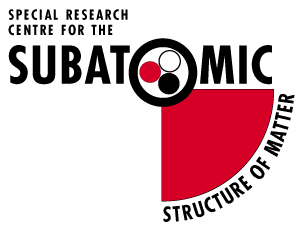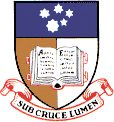![]()


![]()
Hadronic Physics with
PHOTON BEAMS
![]()
Joint Workshop of the
Special Research Center for the Subatomic
Structure of Matter
and the
National Institute for
Theoretical Physics
at the
University of Adelaide



|
Organizing Committee:
A.R. Dzierba (Indiana)
|
|
Scientific Secretary:
W. Melnitchouk |
General Information:
The Centre for the Subatomic Structure of Matter (CSSM) and the National Institute for Theoretical Physics (NITP) at the University of Adelaide, together with Indiana University and the Thomas Jefferson National Accelerator Facility (Jefferson Lab), Virginia, are holding a joint Workshop on Hadronic Physics with Photon Beams at the University of Adelaide on February 16 - 18, 2000.
This workshop will focus on the exciting physics opportunities available with high-quality photon beams in the energy range from 6 to 12 GeV, in particular the search for unusual mesons and gluonic excitations as outlined in the Jefferson Lab Hall D proposal.Physics:
The spectrum of light quark meson states below the charm threshold is known to be much richer than that expected from the naive quark model. However, while lattice QCD and some QCD-inspired models predict the existence of glueball and mesonic states with exotic quantum numbers, their experimental identification has thus far proved extremely difficult.
At present most information about meson spectroscopy comes from experiments involving hadronic beams, such as pions or kaons. The photon, on the other hand, through its coupling to quark-antiquark pairs, is a very different probe of hadronic structure. Being the only spin-1 beam accessible in Nature, it is more likely to produce hybrid states with exotic quantum numbers than scalar beams, and is therefore ideal for the study of quark-antiquark or gluonic excitations.
At Jefferson Lab, the Hall D photon beam will be unprecedented in quality (beam spot size, energy resolution, duty factor), and with fluxes in excess of 107 photons/sec the yields will surpass the combined statistics accumulated in hadroproduction.
Some of the topics to be discussed at this workshop will include:
- Meson spectroscopy
- Glueballs and hybrids
- Strange mesons
- Strong QCD and confinement
- Lattice QCD
- Chiral dynamics
- Rare decays and symmetry tests
- Partial wave analyses with linearly polarized photons
- Photoproduction mechanisms
Program:
The list of participants and the workshop program are now available.International Visitors:
Visitors should take note that immediately following this workshop there will be the International Conference on Quark Nuclear Physics will be held in Adelaide on February 21 - 25, 2000.
International attendees should also make sure that they have the correct visa to enter Australia. Check with the Australian Embassies or Consulates abroad for details.Location:
The National Institute for Theoretical Physics (NITP) and the Special Research Centre for the Subatomic Structure of Matter (CSSM) at the University of Adelaide are located at:
Level 4, 10 Pulteney St.
Adelaide 5005, Australia
CLICK HERE to see map
(CSSM is in bottom right hand
corner of map, Q-12)Accommodation:
There are a number of options for Visitor Accommodation available. To make a booking contact Sharon Johnson.Registration Fee:
A registration fee of A$150 (approx. US$100; A$75 for students) will cover the costs for the reception, continuous brewed coffee and cookies, and workshop dinner (Jasmin Indian restaurant).
To register, fill out the Registration Form.Proceedings:
Proceedings of the workshop will be published. Details will be provided shortly.
